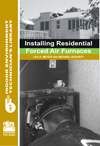Nearly every home or business could benefit from forced air zoning. The question is, “Why are more contractors and or builders not offering this value-add to their clientele?” A couple common responses we hear in the field are, “It’s too complicated,” or “Installing zoning leads to too many call backs.” Sound familiar? The truth is, this used to be the case. However, zoning has evolved, and it can benefit the technician in a big way. Whether you’re a seasoned technician that has been offering zoning for 30 years, or you’re a trainee that has stumbled across your first system, nearly every tech in the industry has dealt with zoning. Before we dig in, let’s cover exactly what forced-air zoning is, for those a little less familiar.
WHAT IS FORCED-AIR ZONING?
As an example, we are going to focus solely on residential zoning applications. Zoning is a solution that compensates for variations in load throughout a home. When properly installed, a zoning system could save homeowners up to 40 percent on their annual energy consumption. A zoning system consists of thermostats, a control panel, and zone dampers. Zones can be laid out in a number of ways, including according to load differences such as upstairs/downstairs or east-to-west, or according to activity, such as bedrooms versus living spaces.
Each zone is equipped with its own thermostat that sends calls to the zone control panel, rather than directly to the equipment. Each zone will also be equipped with at least one zone damper. The zone control panel is then wired directly to the HVAC equipment. As the thermostats call, the zone panel monitors calls and determines the appropriate calls to relay to the equipment, while simultaneously opening dampers to the zones that are calling and closing the dampers to the zones that are not. This is where zoning begins to get hairy!
STATIC PRESSURE AS IT RELATES TO FORCED-AIR ZONING
Static pressure is the result of all resistance to airflow met in the ductwork. There are several variables that cause an increase in static pressure. For example, bends and turns in the ductwork, the evaporator coil, the system blower, and you guessed it, zone dampers! When non-calling zone dampers completely shutoff airflow to a zone, static pressure can increase significantly, leading to a plethora of potential problems. Think of it as sticking your thumb over a garden hose. When the equipment is forced to work harder to push air through the ductwork due to an increase in static pressure (resistance), both system efficiency and durability are compromised. Additionally, systems become susceptible to duct leakage and noise.
Traditionally — to control static pressure in a zoning system — a bypass damper is utilized. This is a special damper installed in a section of ductwork that goes directly from the supply to the return air duct on the air handler. The damper is then configured to open as static pressure rises in order to prevent it from exceeding the set threshold, typically between .35-.4 iwg. The problem with this approach is, when freshly conditioned discharge air is dumped directly into the return to be re-heated or re-cooled it is common for the system to exceed discharge air limits and either malfunction or shutdown, leading to unwanted service calls. In serious situations, such malfunctions can lead to a busted evaporator coil or cracked heat exchanger, among other things. When conditioned air is bypassed, system efficiency is also compromised. Adding to the potential problems that occur with a bypass damper, is all the guess-work involved when appropriately installing and adjusting it. Sometimes, it is impossible to even install a bypass damper. This is where zoning used to be complicated! It is for these reasons that the iO-ESP bypass-free zoning system was developed.
BYPASS-FREE ZONING WITH ELECTRONIC STATIC PRESSURE CONTROL
The iO-ESP bypass-free zoning system has simplified forced air zoning installation in a BIG way. The system comes with a static pressure sensor in place of a bypass damper. Rather than spending the money, time, and effort to install a bypass damper and ductwork, a single hole is drilled into the supply air duct and a pitot-tube is inserted that is attached to the static pressure sensor, which is wired directly to the zone control board. We have eradicated the need for a bypass damper and eliminated all guess-work involved when dealing with static pressure in a zoning system.
This is how it works: when the system calls, the non-calling zone dampers will begin to close, and static pressure starts to rise. If static pressure exceeds the setpoint on the static pressure sensor, the ESP system will hold open or power open the non-calling zone dampers just enough to relieve excess pressure. The ESP system will continually self-regulate for the lifetime of the zoning system. The ESP system is non-communicating and is universally compatible with most thermostat controls, including wireless and Wi-Fi controls offered by other manufacturing companies. The system works with our 3 wire round dampers, rectangular dampers, or retrofit round dampers. For contractors that are interested in free training, samples, or locating a local wholesaler, please call (888)-359-0362 or email: info@iohvaccontrols.com. Thank you for reading.
Want more HVAC industry news and information? Join The NEWS on Facebook, Twitter, and LinkedIn today!











